Watch descriptive video -
This past summer while camping we had a difficult time getting water from the 6-gallon water jugs to the sink. It involved lifting the heavy jugs to pour water into a 55-gallon barrel, and using a sloppy hand pump to pump water to a 15 gallon barrel above the sink. Then the water would flow down to the sink through a hose with a shut off valve. The results were spilled water on the floor of the tent, a lot of work hand pumping water, wasted water because of the continuous flow of water from the barrel above the sink, and strenuous, dangerous lifting of water jugs. We had clean water at this camp, but if it needed filtering, this system would need to be modified.

We knew we had to have a better way to manage this precious resource when camping long term. So I set out to build a system with these objectives:
- Deliver clean water to the kitchen sink
- Conserve water and eliminate waste
- Provide adequate water flow
- Avoid lifting of heavy containers, eliminating potential for injury
- Eliminate spillage
- Option to use clean or dirty water
- Enough storage to avoid having to process water every day
This new water system accomplishes every objective. This is for the food prep and dish washing area of my kitchen. I strongly suggest that one have a separate hand-washing sink to keep germs from hand washing away from where your food is prepared and your dishes washed.
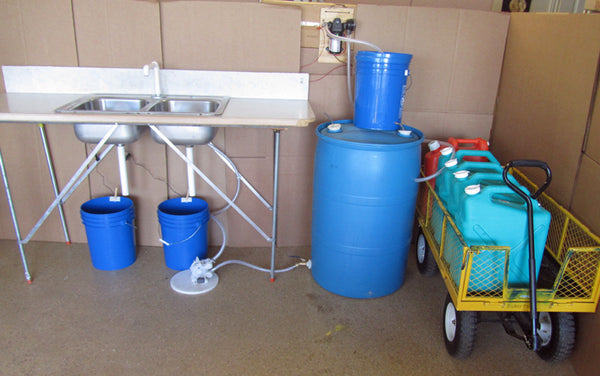
Let’s start at the beginning of the system –
One of the easiest ways of getting water to your tent is a garden cart. Here is a cart with five 6-gallon jugs. So the weight of the water and jug is around 50 pounds each – 300 pounds. This is the cart that I swapped out the pneumatic tires and installed flat free tires. You can read about that in my blog post Garden Carts and Flat Free Tires.
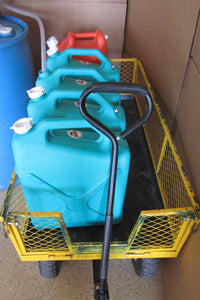
I put my wagon next to the 55-gallon barrel, take the lid off one of the jugs and put the long hose into the jug. The hose is connected to a 12 volt DC water pump that pumps about 3 gallons a minute. The pump is powered by a 12 volt solar system. On this side of the pump is an inline filter. This is the first of a 3 step filtering process. This inline filter provides:
- Fine 40 mesh stainless steel filter screen.
- Filters particles in the water and prevents unnecessary pump breakdowns
- Transparent housing allows instant inspection
- Screw off top allows quick in-place cleaning and removal of debris
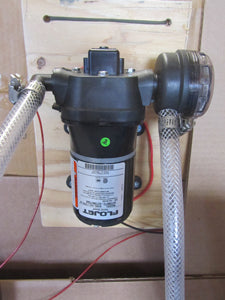
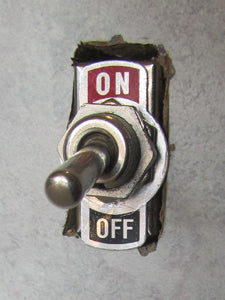
There is a low voltage toggle switch on the upper right side of the sink back splash. It is easy to reach and use. It is important that the switch be low voltage or it won't work.
The water goes through the filter and the pump into the bucket that includes two more filters. First the water goes into this one-micron polyester felt filter bag that filters everything out down to the one-micron level. I cut out the lid and the filter fits nicely allowing the water to quickly filter through.
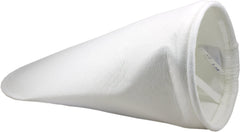
Next the water gravity feeds through a fitting on the bottom of the bucket through a Sawyer Point One filter. This highly effective filter cleans out any E. coli, Giardia, or Cryptosporidium or other bacteria.
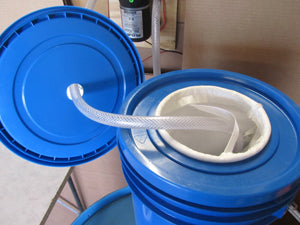

Because the water is pre-filtered before it hits the Sawyer, it avoids clogging the filter fast. Plus the Sawyer has the ability to be cleaned out should it become clogged. This five-gallon bucket takes about 60 minutes to filter. I have the ability to add a second bucket on top and filter water through both holes on top. So the system can filter up to 10 gallons an hour.
The reason for the extra lid on the bucket is so I can easily lift the lid off to see how full the bucket is while pumping, making sure it doesn't overfill. When the bucket is full, I slip this over the bucket to keep any dust getting into the bucket. I like the style of lid found at Home Depot. It slips on easily.
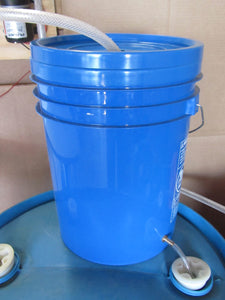
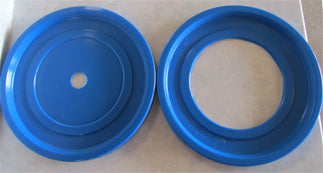
I like having a 55-gallon barrel for storage. That means that I don’t have to worry about processing water every day. To determine how much water I have in the big barrel, I just give it a push. If I can’t move it, I have enough water. If I move it easily, I know I need to process some more water. I can also look down one of the whole on top to see exactly how much water is there.
Fresh Water - If I was getting water from a clean source and didn’t need to filter it, I would simply pump the water from the water jugs directly into the barrel, eliminating the need for the filters.
Next, there is a shut off valve at the bottom of the barrel that can be turned on or off with a foot. The water flows to a heavy duty, high-capacity foot pump. This is a double-action pump meaning it pumps water when the pedal is going down and when it goes up. It pumps 4 gallons a minute, which is three fourths as much as my kitchen faucet.
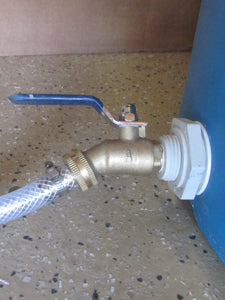
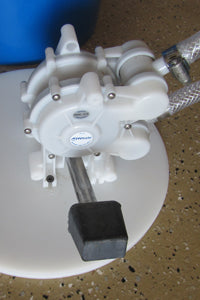
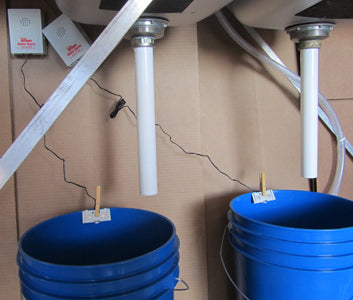
I recognize that this is a system that only works in warm weather when water is a fluid. In freezing weather everything changes.
Here are links for the major parts for this system should you want to build it yourself.
Don’t hesitate to email me at Michael@DeluxeCamping.com with any questions.
 USD
USD EUR
EUR


Debbie says...
Wow…amazing thank you for doing this and then sharing with us!! Your Awesome!!!
On November 06, 2016